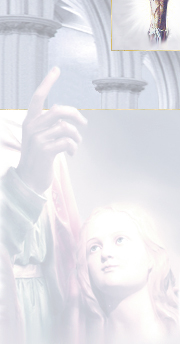|
|
|
Learning How to Pray |
Spiritual Counsels |
Books |
About CSF
 OW
sad and tragic that most Catholics today do not understand much about reverence for the Holy Eucharist. And
it’s also sad and tragic that many priests today are either afraid to teach true reverence for the Holy Eucharist
or are indifferent to the truth. It’s no wonder that darkness and decline in the Church are growing. OW
sad and tragic that most Catholics today do not understand much about reverence for the Holy Eucharist. And
it’s also sad and tragic that many priests today are either afraid to teach true reverence for the Holy Eucharist
or are indifferent to the truth. It’s no wonder that darkness and decline in the Church are growing.
Here, then, are the beginnings of a revival of reverence
for the Holy Eucharist—a revival based on a heartfelt mystical love for Christ and His Real Presence in the
Holy Eucharist that reverberates through all conduct in a church. In short, if you really loved Christ as
your God, you would act accordingly at all times, and this includes reverent and modest conduct as well
as pious reception of the Holy Eucharist.
Revering Sundays
According to the Precepts of the Church,
all Catholics must attend Mass every Sunday and must rest from servile labor on Sundays. Anything
less than this defiles reverence for the holy mystery of Christ’s resurrection—and that leads you away from
revival and right into neglect.
Modest Attire in a Church
For both men and women, immodesty
is a grave opening to the sins of pride and lust. Note that we wear clothing to
give our bodies dignity. Modest clothing covers our bodies with dignity, whereas immodest clothing
reveals the body by making a pretense of covering it, and through this pretense the body becomes
an instrument of social acceptance, an expression of vanity and pride, and a provocation to lust.
Therefore, modest clothing, for both women and men,
should cover the body with dignity rather than reveal the body. Accordingly, all reverent Catholic men
and women avoid the lustful display of tight and revealing clothing, and the prideful
display of sports insignia, piercings, and tattoos. (If you have an existing
tattoo, cover it in sorrow for having defiled your body, the
temple of the Holy Spirit.)
For women, wear mid-calf-length skirts or dresses.
Do not wear leggings, jeans, or slacks. Keep your shoulders, neck, and chest covered. Cover your
head with a chapel veil when in church and whenever you are in the presence
of the Holy Eucharist (as in a Eucharistic Procession).
For men, wear dress clothes. Do not wear jeans,
shorts, T-shirts, or sneakers.
Entering a Church
On entering a church, reverent Catholic women cover
their heads by putting on their chapel veils, and reverent Catholic men uncover their heads by
removing their hats, beanies, or anything else covering their heads.
After showing this initial respect for Christ, then reverent
Roman Catholics look to the tabernacle and genuflect in adoration while saying silently, “My Lord and
my God.” (Note that if the Blessed Sacrament is exposed in a monstrance on the altar, the proper
respect is a prostration; that is, first kneel and then bend forward to touch your head to the
floor.)
 |
A genuflection is a sign of adoration
due to God. To make a proper genuflection, keep your back straight, bend your left leg, and
touch your right knee to the floor while looking at the tabernacle. A careless genuflection
amounts to genuflecting to the thin air.
Note that a curtsy is just a half-hearted imitation of a genuflection; a curtsy is
a sign of respect that may be given to royalty, but it is not a sign of reverence for the divine.
Note also that a bow, in the Roman rite, is simply a sign of respect, as would be
given to an altar with no tabernacle behind it. Therefore, to bow, rather than to genuflect, before
the Blessed Sacrament is to give the appearance of “respecting” Christ while secretly denying His
Real Presence. |
 |
Be careful to arrive on time (before the priest
enters the sanctuary). Always plan to arrive early, and, if you do arrive late (for any reason), stay
in the back of the church so as to not create a disturbing distraction to others, and do not receive
the Holy Eucharist (as an expression of sorrow for the fact that your late presence has deprived you
of an intimate closeness to your Lord and God).
In a Church
Maintain a general attitude of sacred silence in the
church (except when singing or reciting liturgical responses). If you must communicate with someone,
speak only in a reverent whisper.
 At the
beginning and end of the Liturgy, when the Sign of the Cross
is made by all, make the sign with proper respect and attention. If you make the Sign of the Cross
as most others tend to do it (that is, routinely, quickly, and with an open hand) you give the impression
that you are brushing flies away from your face. Therefore, hold your thumb so that it touches your first
two fingers, let your ring finger and little finger curl into your palm, and make the Sign of the Cross
motion slowly and mindfully. At the
beginning and end of the Liturgy, when the Sign of the Cross
is made by all, make the sign with proper respect and attention. If you make the Sign of the Cross
as most others tend to do it (that is, routinely, quickly, and with an open hand) you give the impression
that you are brushing flies away from your face. Therefore, hold your thumb so that it touches your first
two fingers, let your ring finger and little finger curl into your palm, and make the Sign of the Cross
motion slowly and mindfully.
Bow your head whenever the name of Jesus or Mary is
mentioned during the liturgy.
When standing during the liturgy, stand reverently with your hands clasped in front of you. Standing
with your arms crossed is a sign of defiance.
Never engage in hand clapping, for any reason, at any time while in the church, because clapping
is an act of human pride that usurps the honor due to Christ alone.
If, in your movement around the church, if you should ever cross before the tabernacle, even if you
may be in the back of the church, stop, turn and face the Tabernacle, and then genuflect before
it.
Receiving the Holy Eucharist
Fast (i.e., abstain from food) for at least an hour
before receiving the Holy Eucharist, according to Canon law (Can. 919 §1). And for that matter, fast for
an hour after receiving. It’s admirable to not send Christ into a pit of half-digested food, but it
is just as admirable to not pour garbage (such as coffee and donuts) on Him after you receive Him.
In the Roman rite, receive the Holy Eucharist only from the hands of a priest (or deacon) and never from a
lay person. Receive kneeling, on the tongue, and never in your own hands.
 |
To assist the priest in placing the
Host on your tongue without him touching you, tilt your head back, extend your tongue, and curl
the tip of your tongue down as if you were trying to touch your chin. |
 |
Leaving a Church
On leaving a church, look to the tabernacle and
genuflect while saying silently, “My Lord and my God.”
Note that if the Blessed Sacrament is exposed in a
monstrance on the altar, the proper respect is a prostration; that is, first kneel and then
bend forward to touch your head to the floor.
Exit silently, and, if you must speak
with someone or use your telephone, do so in the foyer or outside the church.
Summary
Remember: genuine reverence begins with you,
and neglect also begins with you. Therefore, now that you have learned proper Catholic
conduct in a church, turn your attention to living a holy life
interiorly, wherever you may be, and not just in a church.
Additional information not on
this current webpage but found in the book:
The Veil of Purity
Confession
Act of Reparation
Deliverance From the Tyranny of Evil
The information on this webpage
(and more) is available at your fingertips in book form.
 |
 |
Reverence for the Holy Eucharist
Reverent and Proper Conduct In a Catholic Church
by Raymond Lloyd Richmond, Ph.D.
On reading this book, you might be astonished that no one ever told you about these
things. Most likely, you didn’t learn about reverence from your parents because they
didn’t know much about reverence and weren’t inclined to learn. You didn’t learn about
reverence from priests at Mass most likely because they were afraid to hurt the
feelings of others by teaching the truth. And you didn’t learn about reverence from
others at Mass because they were all following the same neglect as those around them.
So remember: although neglect will continue with others, reverence must begin with
you. |
CONTENTS
Preface | Revering Sundays |
Modest Attire in a Church | Entering a Church | In a Church |
Receiving the Holy Eucharist | Leaving a Church | Summary | Confession |
The Rest of the Story

Appendix I: Act of Reparation

Appendix II: Renunciation Prayer for Illness

Appendix III: Renunciation Prayer for Irreverence

Appendix IV: Prayer for Deliverance from the Tyranny of Evil

Notes
Paperback book |
 |
eBook |
5.25" x 8"
68 pages
ISBN: 979-8307139196 |
|
Formatted for Kindle
devices and Kindle apps for iPad, iPhone, iPod touch, PC, Mac, Blackberry,
and Android-based devices. |
Order from Amazon.com

Reverence for the Holy Eucharist

|
|
Buy from
Amazon.com

In process
|
|




 At the
beginning and end of the Liturgy, when the
At the
beginning and end of the Liturgy, when the 